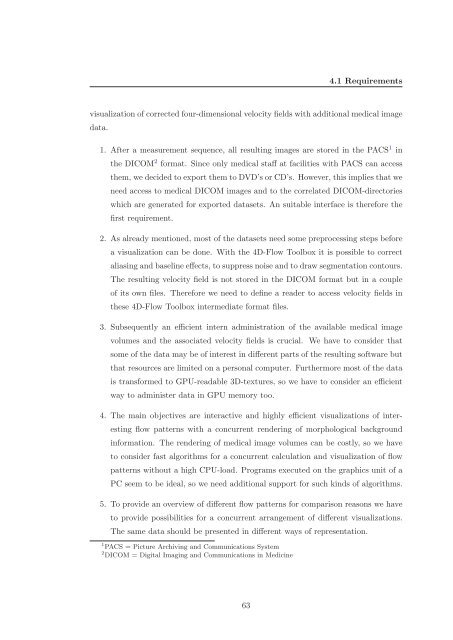Master's Thesis - Studierstube Augmented Reality Project - Graz ...
Master's Thesis - Studierstube Augmented Reality Project - Graz ...
Master's Thesis - Studierstube Augmented Reality Project - Graz ...
Create successful ePaper yourself
Turn your PDF publications into a flip-book with our unique Google optimized e-Paper software.
4.1 Requirements<br />
visualization of corrected four-dimensional velocity fields with additional medical image<br />
data.<br />
1. After a measurement sequence, all resulting images are stored in the PACS 1 in<br />
the DICOM 2 format. Since only medical staff at facilities with PACS can access<br />
them, we decided to export them to DVD’s or CD’s. However, this implies that we<br />
need access to medical DICOM images and to the correlated DICOM-directories<br />
which are generated for exported datasets. An suitable interface is therefore the<br />
first requirement.<br />
2. As already mentioned, most of the datasets need some preprocessing steps before<br />
a visualization can be done. With the 4D-Flow Toolbox it is possible to correct<br />
aliasing and baseline effects, to suppress noise and to draw segmentation contours.<br />
The resulting velocity field is not stored in the DICOM format but in a couple<br />
of its own files. Therefore we need to define a reader to access velocity fields in<br />
these 4D-Flow Toolbox intermediate format files.<br />
3. Subsequently an efficient intern administration of the available medical image<br />
volumes and the associated velocity fields is crucial. We have to consider that<br />
some of the data may be of interest in different parts of the resulting software but<br />
that resources are limited on a personal computer. Furthermore most of the data<br />
is transformed to GPU-readable 3D-textures, so we have to consider an efficient<br />
way to administer data in GPU memory too.<br />
4. The main objectives are interactive and highly efficient visualizations of interesting<br />
flow patterns with a concurrent rendering of morphological background<br />
information. The rendering of medical image volumes can be costly, so we have<br />
to consider fast algorithms for a concurrent calculation and visualization of flow<br />
patterns without a high CPU-load. Programs executed on the graphics unit of a<br />
PC seem to be ideal, so we need additional support for such kinds of algorithms.<br />
5. To provide an overview of different flow patterns for comparison reasons we have<br />
to provide possibilities for a concurrent arrangement of different visualizations.<br />
The same data should be presented in different ways of representation.<br />
1 PACS = Picture Archiving and Communications System<br />
2 DICOM = Digital Imaging and Communications in Medicine<br />
63





